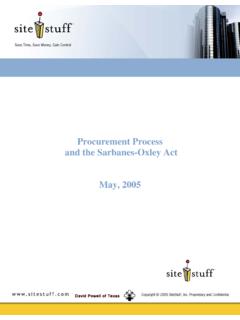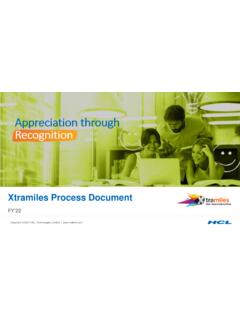Transcription of Cisco SD-WAN: Enabling Firewall and IPS for Compliance
1 Cisco SD-WAN: Enabling Firewall and IPS. for Compliance Prescriptive Deployment Guide September, 2020. 1. Table of contents Introduction .. 4. About the Guide .. 4. 5. Define .. 6. About the Solution .. 6. Benefits of Deploying SD-WAN Security for PCI Compliance .. 7. Design - Cisco SD-WAN Security - Compliance Use Case .. 8. Use case #1 - Compliance .. 8. SD-WAN Security Design Components .. 8. Transport Security .. 9. Secure Segmentation .. 10. Enterprise Firewall with App Aware .. 12. Intrusion Prevention System .. 14. SD-WAN Compliance Use Case Packet flow .. 19. Deploy - Cisco SD-WAN Security - Compliance Use Case - Prerequisites .. 21. Prerequisites .. 21. Deploy - Cisco SD-WAN Security - Compliance Use Case .. 34. Configuration Workflow .. 34. Process 1: IPS Signature 34. Process 2: Create Security Policy - Enterprise Firewall with App Aware (Application Firewall ) and IPS Policy.. 36. Process 3: Attach the Security Policy to the Device Template.
2 56. Operate - Cisco SD-WAN Security Compliance Use Case .. 61. Process 1: Monitor the Enterprise Firewall with App Aware Feature via vManage NMS .. 61. Procedure 1: Monitor the Firewall Feature via vManage Main Dashboard .. 61. Procedure 2: Monitor the Firewall Feature via vManage Monitor Dashboard .. 64. Procedure 3: Monitor the Firewall Feature and Statistics via vManage SSH Server Dashboard .. 69. Process 2: Monitor IPS Feature via vManage NMS .. 72. Procedure 1: Monitor IPS Signature Violations via vManage Main Dashboard .. 72. Procedure 2: Monitor IPS Feature via vManage Monitor Dashboard .. 75. Procedure 3: Monitor IPS Feature and Statistics via vManage SSH Server Dashboard .. 79. Process 3: Monitor IPS Signature Violations via Syslog Server .. 83. Appendix A: New in this Guide .. 84. Appendix B: Hardware and Software Used for Validation .. 85. Appendix C: Deployment Example .. 86. Topology .. 86. System IP Address and Site ID .. 86. 2. Appendix D: Cisco WAN Edge Configuration Summary (Templates).
3 88. Feature Template .. 88. Security Policy feature template .. 88. Container Profile feature template .. 90. Device Template .. 90. Example Branch Configuration .. 91. Branch 122003: BR2-WAN-Edge1: 91. Appendix E: Glossary .. 98. About this guide .. 99. Feedback & discussion .. 99. 3. Introduction Introduction About the Guide This document provides information on the design and deployment of the Cisco SD-WAN security infrastructure specific to the Compliance use case within remote sites running IOS-XE SD-WAN WAN edge platforms. The security features leveraged within this guide include Enterprise Firewall with Application Awareness and Intrusion Prevention System (IPS). The guide explains the platforms deployed at length, highlights the best practices, and assists with the successful configuration and deployment of security features. However, the document is not exhaustive in terms of covering all possible deployment options. This document assumes that the controllers are already deployed and integrated into vManage, the WAN.
4 Edge devices are deployed and the SD-WAN overlay network is successfully established. Refer to the Cisco SD-WAN Design Guide for background information and the Cisco SDWAN Deployment Guide for information on deploying device templates to establish a Cisco SD-WAN overlay network. This document contains four major sections: The Define section defines the shortcomings of a secure traditional WAN architecture, to then explain the benefits of deploying SD-WAN security solution. The Design section includes the use case covered in the guide, along with the design components and considerations in order to deploy the security features. The Deploy section discusses the automated deployment of the Cisco SD-WAN security features specific to the Compliance use case using the vManage security policy dashboard. The section also includes the prerequisites to deploy this security solution. The Operate section explains some of the monitoring and troubleshooting methods used when Cisco SD-WAN security features, Enterprise Firewall with Application Awareness, and IPS are configured.
5 Implementation Flow 4. Introduction Refer to Appendix B for the hardware models and software versions used in this deployment guide, Appendix C for the topology and Appendix D for the feature and device templates, along with the CLI- equivalent configuration for one of the WAN edge devices configured. Audience The audience for this document includes network design engineers, network operations personnel, and security operations personnel who wish to implement the Cisco SD-WAN security infrastructure for PCI. Compliance within SD-WAN enabled remote sites. 5. Define Define About the Solution Companies handling credit card information are required to maintain data in a secure manner that reduces the likelihood of sensitive financial data from being stolen. If merchants fail to securely handle credit card information, that data could be hacked and used to make fraudulent purchases. Additionally, sensitive information about the cardholder could be used in identity fraud.
6 As the attack surface at the branch continues to increase, the need to protect sensitive information with the right security capabilities within the branch site before that data is tunneled over to the data center is critical. Companies that store, process or transmit cardholder data are required to inspect all the packets that leave the branch, by a stateful Firewall and an IPS solution, and this is required before the data is tunneled over to the data center. The solution is to deploy and maintain Cisco SD-WAN within your WAN infrastructure, which allows you to manage your SD-WAN WAN network centrally via Cisco vManage GUI and leverage the security capabilities embedded natively in the SD-WAN single-pane of management to secure traffic within the remote site before it is tunneled over to the data center. PCI Compliance Traffic flow The security capabilities available within the security policy dashboard on vManage include Enterprise Firewall with Application Awareness (Application Firewall ), Intrusion Prevention System (IPS), URL-Filtering, Advanced Malware Protection (AMP), and DNS/Web-layer Security.
7 VManage includes predefined workflows to facilitate several use cases based on intent, such as: 1) Compliance (Application Firewall | Intrusion Prevention). 2) Guest Access (Application Firewall | URL Filtering). 3) Direct Cloud Access (Application Firewall | Intrusion Prevention | Advanced Malware Protection | DNS. Security). 4) Direct Internet Access (Application Firewall | Intrusion Prevention | URL Filtering | Advanced Malware Protection | DNS Security). In addition, you can build your own custom policy by combining a custom variety of security features. 6. Define Within this solution, the security features available within the intent-based use case for Compliance are leveraged. Benefits of Deploying SD-WAN Security for PCI Compliance Simple and Automated Security Solution: The intent-based workflow is designed for ease of configuration and deployment of the SD-WAN security solution. The workflow allows you to fill out the template to include all of the security capabilities and deploy it on multiple devices at the same time.
8 Comprehensive SD-WAN Security: With security capabilities such as Enterprise Firewall with App Aware Firewall (Application Firewall ) and IPS enabled on your WAN edge device, you can do the following. 5) Restrict access to certain Internet destinations for remote employees and guests, with improved application experience. 6) Protect the internal network from malware and/or malicious content in real-time. 7) Prevent any additional cost as deploying the Cisco SD-WAN security solution eliminates the need to deploy any additional equipment within your SD-WAN network to enable security features. Centralized Management: Deploy, troubleshoot and monitor the SD-WAN overlay solution with security capabilities across WAN edge devices centrally via the Cisco vManage GUI. 7. Design - Cisco SD-WAN Security - Compliance Use Case Design - Cisco SD-WAN Security - Compliance Use Case Use cases are part of the vManage security policy. Out of the four intent-based use cases available, Compliance is the predominant one for enterprise customers.
9 Use Case #1 - Compliance Within the Compliance use case, the primary requirement is to protect sensitive data, such as card holder or patient information, against data breaches. This makes it necessary to inspect traffic before it is tunneled across to the data center. In the Cisco SD-WAN solution, although data plane traffic is encrypted and sent over a VPN tunnel, for Compliance , all packets need to be subjected to a stateful Firewall and an IPS solution. Four security pillars are required to maintain a PCI-compliant network: Security Pillars Transport Security IPsec VPN. Perimeter Control Firewall Segmentation VPN/FW Zone Attack Prevention IPS. In the following figure, the traffic traversing from VPN 1 is inspected via Cisco SD-WAN security features, such as Enterprise Firewall with Application Awareness and Intrusion Prevention System before being tunneled and sent over to the datacenter (based on the destination from data center to Internet).
10 Traffic Flow Compliance Use Case For details regarding other use cases, refer to the SD-WAN Security Policy Design guide. SD-WAN Security Design Components In the following section, the four security pillars required to maintain a PCI-compliant network are discussed in depth. 8. Design - Cisco SD-WAN Security - Compliance Use Case Transport Security The first security pillar in PCI Compliance is establishing a secure transport. IPsec connections are established across transports between Cisco WAN Edge devices via key exchange to authenticate and encrypt data packets. In Cisco SD-WAN, once the control plane communication is established between the WAN edge device and vSmart controller, each of the WAN edge devices generates a pair of keys, an encryption key and a hashing key per transport route. In the figure, we have two transport routes, hence two encryption keys are generated from WAN Edge-1 (encryption key 1 and encryption key 2). The encryption and hashing keys are sent to the vSmart controller as an OMP update from the WAN Edge device.















